Manual
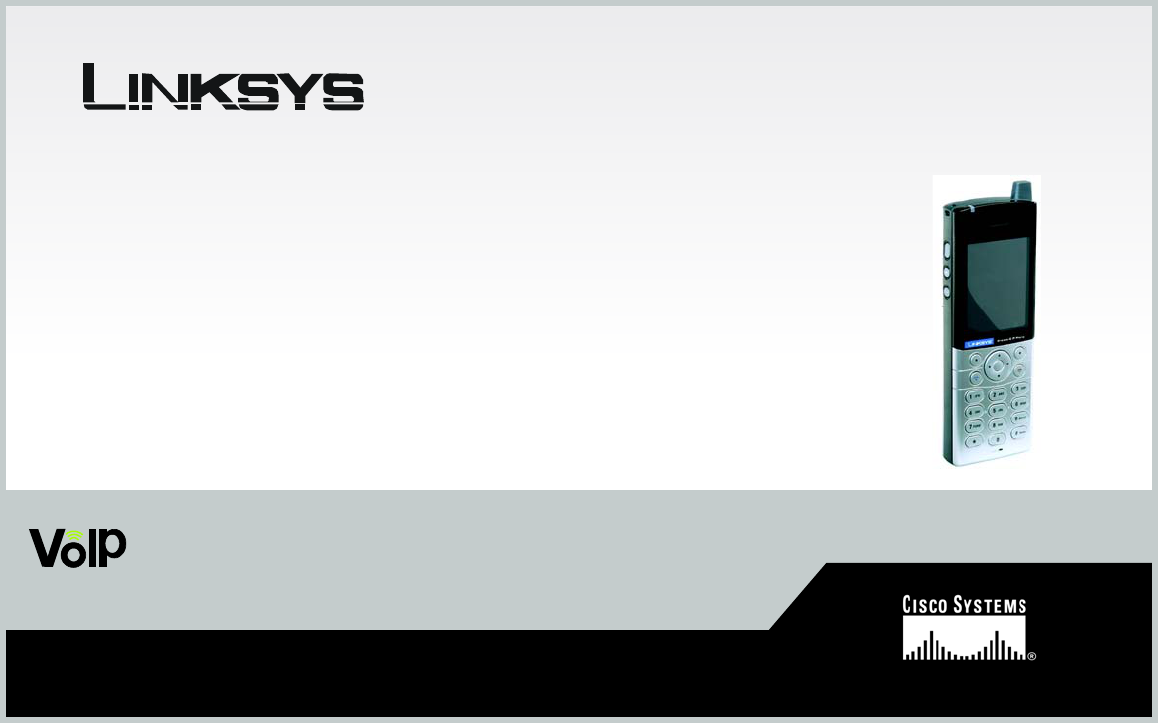
A Division of Cisco Systems, Inc.
®
User Guide
Model No.
WIP330
IP Phone
Wireless-G
Voice

Wireless-G IP Phone
Copyright and Trademarks
Specifications are subject to change without notice. Linksys is a registered trademark or trademark of Cisco Systems,
Inc. and/or its affiliates in the U.S. and certain other countries. Copyright © 2005 Cisco Systems, Inc. All rights
reserved. Other brands and product names are trademarks or registered trademarks of their respective holders.
How to Use this Guide
Your guide to the Wireless-G IP Phone has been designed to make understanding networking with the
IP Phone easier than ever. Look for the following items when reading this User Guide:
In addition to these symbols, there are definitions for technical terms that are presented like this:
Also, each figure (diagram, screenshot, or other image) is provided with a figure number and description, like
this:
Figure numbers and descriptions can also be found in the “List of Figures” section.
This exclamation point means there is a caution or warning and is
something that could damage your property or IP Phone.
This question mark provides you with a reminder about something you
might need to do while using the IP Phone.
This checkmark means there is a note of interest and is something you
should pay special attention to while using the IP Phone.
word: definition.
Figure 0-1: Sample Figure Description
WIP330-UG-51027NC JL
WARNING: This product contains chemicals, including lead, known to the State of California to cause
cancer, and birth defects or other reproductive harm. Wash hands after handling.
Wireless-G IP Phone
Table of Contents
Chapter 1: Introduction 1
Welcome 1
What’s in This User Guide? 1
Chapter 2: Getting to Know the Wireless-G IP Phone 3
The Bottom Panel 3
The Front and Side Panels 4
The Back Panel 6
Chapter 3: Installing and Using the Wireless-G IP Phone 7
Overview 7
Inserting the Battery into the Wireless-G IP Phone 7
Powering on the Wireless-G IP Phone 8
Setting up the Wireless-G IP Phone 10
Using the Wireless-G IP Phone 19
Chapter 4: Configuring the Wireless-G IP Phone 21
Instructions for Configuring the Wireless-G IP Phone 21
Status Information 22
Settings of the Wireless-G IP Phone 23
Appendix A: Troubleshooting 45
Common Problems and Solutions 45
Frequently Asked Questions 51
Appendix B: Glossary 53
Appendix C: Specifications 57
Appendix D: Warranty Information 59
Appendix E: Regulatory Information 61
Appendix F: Contact Information 75
Wireless-G IP Phone
List of Figures
Figure 2-1: Bottom Panel 3
Figure 2-2: Front Panel 4
Figure 2-3: Side Panel 5
Figure 2-4: Back Panel 6
Figure 3-1: Press the Button 7
Figure 3-2: Insert the Battery 7
Figure 3-3: Connect the Power 8
Figure 3-4: Front Panel 9
Figure 3-5: Scan for Wireless Networks 10
Figure 3-6: Select Wireless Network 10
Figure 3-7: Connect to Wireless Network 11
Figure 3-8: Enter WEP Key (for Secured Networks) 11
Figure 3-9: Successful Connection 11
Figure 3-10: Select Menu 12
Figure 3-11: Select SIP Settings 12
Figure 3-12: Edit Proxy IP 13
Figure 3-13: Save Proxy IP 13
Figure 3-14: Save Register Proxy IP 13
Figure 3-15: Save Register Proxy Port 14
Figure 3-16: Save Outbound Proxy IP 14
Figure 3-17: Edit Outbound Proxy Port 15
Figure 3-18: Save Expire Time 15
Figure 3-19: Save Phone Number 16
Figure 3-20: Save User Name 16
Figure 3-21: Save Password 17
Figure 3-22: Save SIP Settings 17
Figure 3-23: Return to Standby Screen 18
Figure 3-24: Standby Screen 18
Figure 3-25: Call Connected 19
Figure 3-26: Line Options 19
Figure 3-27: Second Call 20
Figure 4-1: Front Panel of IP Phone 21
Figure 4-2: Standby Screen 22
Figure 4-3: Standby Screen 23
Figure 4-4: Main Menu 23
Figure 4-5: Call Log 24
Figure 4-6: Select Phone Book 25
Figure 4-7: Phone Book 25
Figure 4-8: Phone Book Options 25
Figure 4-9: Add Person 26
Figure 4-10: Enter Name 26
Figure 4-11: Select Call Option 27
Figure 4-12: Call Option 27
Figure 4-13: Forwarding 27
Figure 4-14: Enter Phone Number 27
Figure 4-15: Select Network Settings 28
Figure 4-16: Network Settings - DHCP 28
Figure 4-17: Enter DNS IP Address 28
Wireless-G IP Phone
Figure 4-18: Network Settings - Fixed IP 29
Figure 4-19: Enter IP Address 29
Figure 4-20: Select Subnet Mask 29
Figure 4-21: Enter Subnet Mask 29
Figure 4-22: Select Phone Settings 30
Figure 4-23: Phone Settings 30
Figure 4-24: Ring Options 30
Figure 4-25: Ring Types 30
Figure 4-26: Keypad Tone 31
Figure 4-27: MSG Tone 31
Figure 4-28: Change Date 32
Figure 4-29: Change Clock 32
Figure 4-30: Change Time Format 32
Figure 4-31: Change Clock Type 32
Figure 4-32: Select Time Zone 33
Figure 4-33: Change Time Zone 33
Figure 4-34: Select NTP Server 33
Figure 4-35: Enter Name of NTP Server 33
Figure 4-36: Language 34
Figure 4-37: Change Power Saving 34
Figure 4-38: Wireless 35
Figure 4-39: Scanning for Wireless Networks 35
Figure 4-40: List of Wireless Networks 35
Figure 4-41: Connecting to Wireless Network 36
Figure 4-42: Enter WEP Key (for Secured Network) 36
Figure 4-43: Connected to Wireless Network 36
Figure 4-44: Wi-Fi Profiles 37
Figure 4-45: Select SSID 38
Figure 4-46: Enter SSID 38
Figure 4-47: Change Wireless Mode 38
Figure 4-48: Change Authentication Mode 38
Figure 4-49: Change Transmit Key 39
Figure 4-50: Edit WEP Key 39
Figure 4-51: Enter WEP Key 39
Figure 4-52: Profile Added 39
Figure 4-53: Edit Proxy IP 40
Figure 4-54: Save Proxy IP 40
Figure 4-55: Save Register Proxy IP 40
Figure 4-56: Save Register Proxy Port 40
Figure 4-57: Save Outbound Proxy IP 41
Figure 4-58: Edit Outbound Proxy Port 41
Figure 4-59: Save Expire Time 41
Figure 4-60: Save Phone Number 41
Figure 4-61: Save User Name 42
Figure 4-62: Save Password 42
Figure 4-63: Save DNS Server 42
Figure 4-64: Change Payload Type 42
Figure 4-65: Web Site 43
Figure 4-66: Visit Web Site 43
Figure 4-67: Enter New Web Address 43
Figure 4-68: Select Drag & Drop 43
Figure 4-69: Information 44

Wireless-G IP Phone
1
Chapter 1: Introduction
Welcome
Chapter 1: Introduction
Welcome
Thank you for choosing the Linksys Wireless-G IP Phone. It will allow you to make phone calls using your
broadband connection, whether you are at home, in your office, or at a public hotspot.
How does the IP Phone do this? It connects to your wireless router or gateway, so telephone service is delivered
through your cable or DSL Internet connection. You can also surf the Internet with its built-in web browser and
backlit, full-color screen.
But what does all of this mean? Networks are useful tools for sharing Internet access and computer resources.
Your voice calls can share your high-speed Internet connection. You will be able to make phone calls using the
account you set up with your Internet phone service provider, even while you’re surfing the Internet on your
computer. So, networks not only are useful in homes and offices, but also can be fun.
Use the instructions in this User Guide to help you connect the IP Phone after you have set up an account with
your Internet phone service provider. These instructions should be all you need to get the most out of the
Wireless-G IP Phone.
What’s in This User Guide?
This guide covers the steps for installing the Wireless-G IP Phone.
• Chapter 1: Introduction
This chapter describes the IP Phone’s applications and this User Guide.
NOTE: For information
about your Internet phone
service, refer to the materials
provided by your Internet
phone service provider.
network: a series of computers or
devices connected for the purpose of
data sharing, storage, and/or
transmission between users.
ip (internet protocol): a protocol used to
send data over a network.
Wireless-G IP Phone
2Chapter 1: Introduction
What’s in This User Guide?
• Chapter 2: Getting to Know the Wireless-G IP Phone
This chapter describes the physical features of the IP Phone.
• Chapter 3: Installing and Using the Wireless-G IP Phone
This chapter explains how to install the IP Phone and use it.
• Chapter 4: Configuring the Wireless-G IP Phone
This chapter discusses how to configure the IP Phone’s settings.
• Appendix A: Troubleshooting
This appendix describes some potential problems and solutions, as well as frequently asked questions,
regarding use of the IP Phone.
• Appendix B: Glossary
This appendix gives a brief glossary of terms frequently used in networking.
• Appendix C: Specifications
This appendix provides the technical specifications for the IP Phone.
• Appendix D: Warranty Information
This appendix supplies the warranty information for the IP Phone.
• Appendix E: Regulatory Information
This appendix supplies the regulatory information regarding the IP Phone.
• Appendix F: Contact Information
This appendix provides contact information for a variety of Linksys resources, including Technical Support.

Wireless-G IP Phone
3
Chapter 2: Getting to Know the Wireless-G IP Phone
The Bottom Panel
Chapter 2: Getting to Know the Wireless-G IP Phone
The Bottom Panel
The IP Phone’s headset jack and USB port are located on the bottom panel.
Headset Jack This jack allows you to connect a headset.
USB Port The USB port allows you to attach the included power adapter.
Figure 2-1: Bottom Panel
Headset
Jack
USB Port
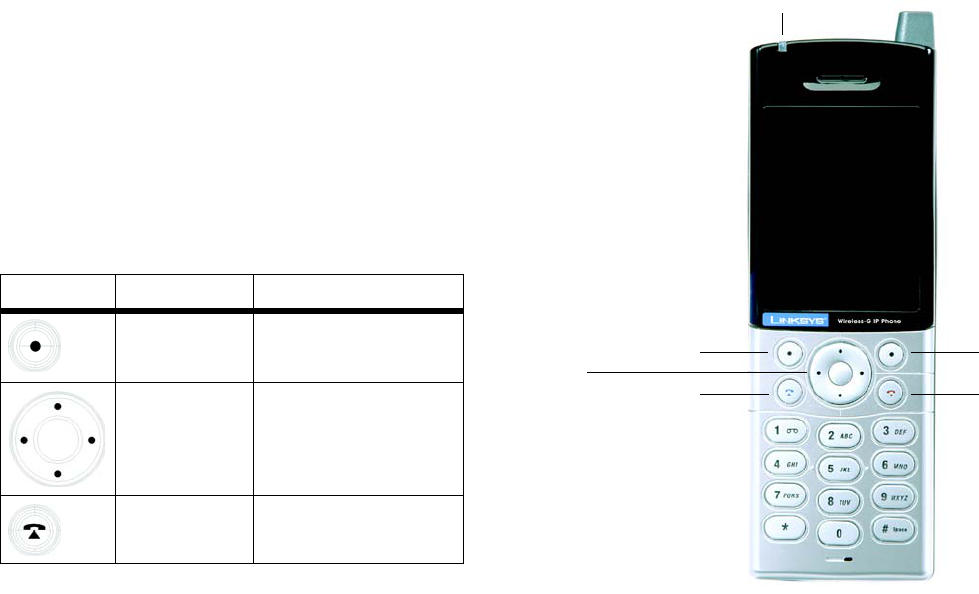
Wireless-G IP Phone
4Chapter 2: Getting to Know the Wireless-G IP Phone
The Front and Side Panels
The Front and Side Panels
The power LED is located at the top of the IP Phone, while its buttons are located on the front and side
panels.
Power LED Blue/Purple. The LED lights up blue when the IP Phone is powered on and ready. It
flashes, alternating between blue and purple, when the IP Phone is re-charging.
When the IP Phone is fully charged and still connected to its power adapter, the LED
will be a solid purple. When the IP Phone is charged and not connected to its power
adapter, the LED will be a solid blue.
The buttons of the IP Phone are described in this table.
Icon Button Name Function
Softkey Selects the appropriate action
shown on the left- or right-
hand side of the screen
Navigation Pad
and Center
Selection Key
Lets you navigate menus and
select your choices
Controls cursor for its web
browser
Call Uses Internet phone line
Figure 2-2: Front Panel
Power LED
Softkey
Power On/Off
or End Call
Softkey
Navigation Pad
and Center
Selection Key Call
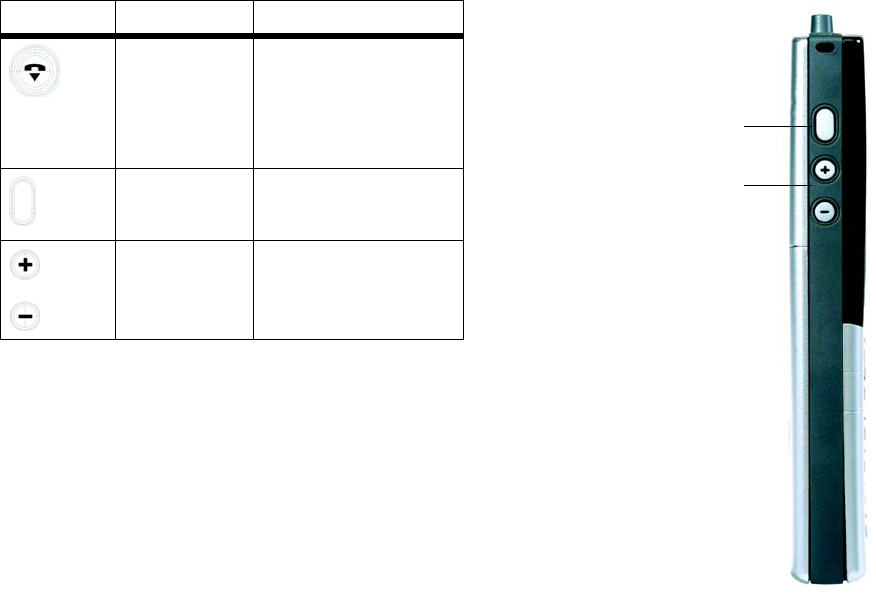
Wireless-G IP Phone
5
Chapter 2: Getting to Know the Wireless-G IP Phone
The Front and Side Panels
Power On/Off or
End Call
Press and hold this button for
two seconds to power the IP
Phone on or off.
Ends the call or exits the
current menu
Speakerphone Switches to speakerphone
(The speaker is located on the
back of the IP Phone)
Volume Raises or lowers the volume
Icon Button Name Function
Volume
Speakerphone
Figure 2-3: Side
Panel
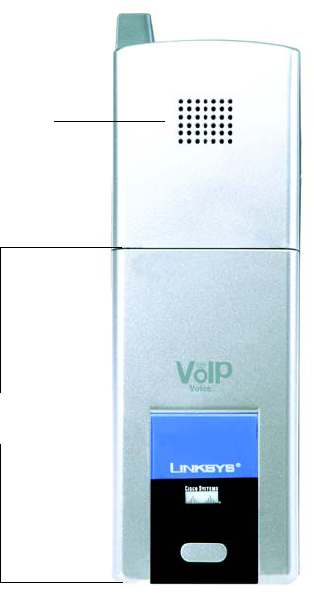
Wireless-G IP Phone
6Chapter 2: Getting to Know the Wireless-G IP Phone
The Back Panel
The Back Panel
The IP Phone’s speaker (for the speakerphone feature) and battery compartment are located on the back panel
of the IP Phone. (The speaker is controlled by the speakerphone button on the side panel. For directions on how
to insert the battery, refer to “Chapter 3: Installing and Using the Wireless-G IP Phone.”
Battery
Compartment
Speaker
Figure 2-4: Back Panel
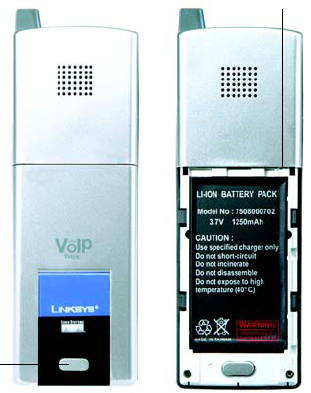
Wireless-G IP Phone
7
Chapter 3: Installing and Using the Wireless-G IP Phone
Overview
Chapter 3: Installing and Using the Wireless-G IP Phone
Overview
This chapter provides instructions for first-time installation and use of the IP Phone. You will insert the battery
into the IP Phone and then set it up for your wireless network and Internet phone service. Then you will be able
to make and receive Internet phone calls.
Inserting the Battery into the Wireless-G IP Phone
To insert the battery, follow these instructions:
1. Remove the cover of the battery compartment. Push down on the button and slide the cover downward.
2. Insert the battery. Make sure the metal contacts of the battery line up with the metal contacts of the
battery compartment.
3. Insert the door and slide it upward until it snaps into place.
Proceed to the next section, “Powering on the Wireless-G IP Phone.”
Figure 3-1: Press
the Button
Figure 3-2: Insert
the Battery
Button
Metal Contacts
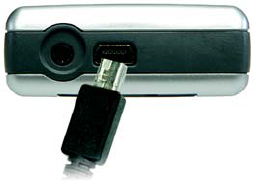
Wireless-G IP Phone
8Chapter 3: Installing and Using the Wireless-G IP Phone
Powering on the Wireless-G IP Phone
Powering on the Wireless-G IP Phone
Make sure you have the account information, including necessary IP Phone settings, supplied by your Internet
phone service provider. If you already have an account set up with your Internet phone service provider, then
proceed to step 1. If you do not have an account, then go to the website of your Internet phone service provider
and sign up for service. After you have set up an account, proceed to step 1.
1. Make sure you have the account information, including necessary IP Phone settings, supplied by your
Internet phone service provider.
2. Plug the USB mini-B connector of the included power adapter into the USB mini-B port of the IP Phone. Then
connect the power adapter to a standard electrical outlet.
Figure 3-3: Connect the Power
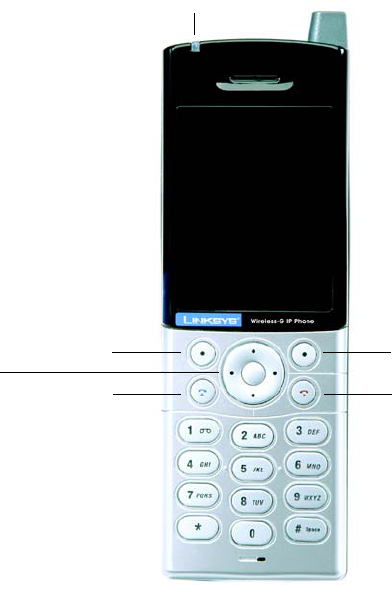
Wireless-G IP Phone
9
Chapter 3: Installing and Using the Wireless-G IP Phone
Powering on the Wireless-G IP Phone
3. The power LED will flash, alternating between blue and purple. For the initial charge, allow the
battery to charge for at least 10 hours, so the battery will have a full charge, which is indicated by a
solidly lit Power LED. This maximizes battery performance and life.
When the battery is fully charged, proceed to “Setting up the Wireless-G IP Phone.”
Power LED
Softkey
Power On/Off
or End Call
Softkey
Navigation Pad
and Center
Selection Key Call
Figure 3-4: Front Panel
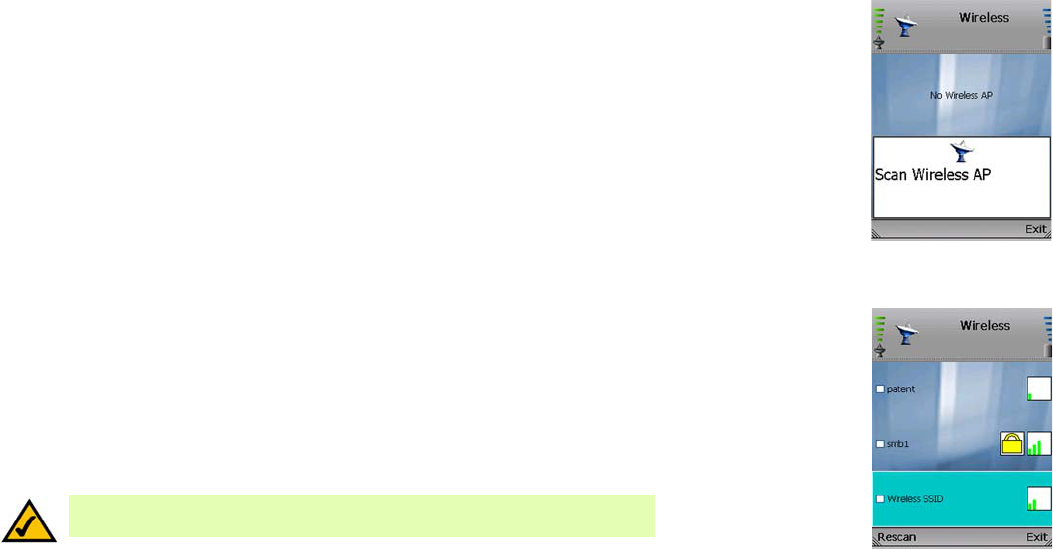
Wireless-G IP Phone
10 Chapter 3: Installing and Using the Wireless-G IP Phone
Setting up the Wireless-G IP Phone
Setting up the Wireless-G IP Phone
Before you begin, make sure your network has an active Internet connection.
1. Press and hold the Power On/Off button for two seconds.
2. The IP Phone will boot up and automatically scan for wireless networks.
3. A list of wireless networks will be displayed and show their wireless network names (also known as Service
Set Identifier or SSID), security status (a lock indicates wireless security), and signal strength, which is
indicated by a bar graph.
Scroll through the network choices, and press the center selection key (in the middle of the navigation pad)
to select the wireless network you want to use.
If the network you want is not shown, select Rescan for a new scan.
Figure 3-6: Select
Wireless Network
Figure 3-5: Scan for
Wireless Networks
NOTE: Press the left softkey to make a selection, and press the right softkey to
return to the previous menu. Use the navigation pad to scroll through menu choices.
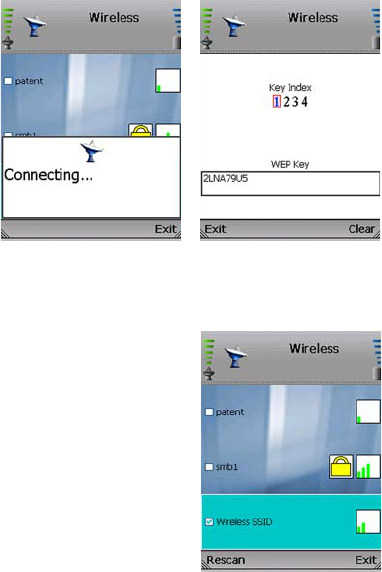
Wireless-G IP Phone
11
Chapter 3: Installing and Using the Wireless-G IP Phone
Setting up the Wireless-G IP Phone
4. The IP Phone will automatically connect to the network you have selected.
If security is enabled on the selected network, a new screen will appear. Using the navigation
pad, select the appropriate transmit key number and then move to the WEP Key field. Enter the
network’s WEP key. Select Exit to save your changes, or select Clear to delete a character or
number.
5. You will be notified when the IP Phone has connected to the network, and a checkmark will appear next to
the name of the network.
Select Exit.
Figure 3-8: Enter WEP
Key (for Secured
Networks)
Figure 3-7: Connect to
Wireless Network
Figure 3-9: Successful
Connection

Wireless-G IP Phone
12 Chapter 3: Installing and Using the Wireless-G IP Phone
Setting up the Wireless-G IP Phone
6. The standby screen will appear. Select Menu.
7. Phone Settings will be highlighted. Navigate the menu choices, and then select SIP Settings. (SIP stands
for Session Initiation Protocol.)
Figure 3-10: Select Menu
Figure 3-11: Select SIP
Settings
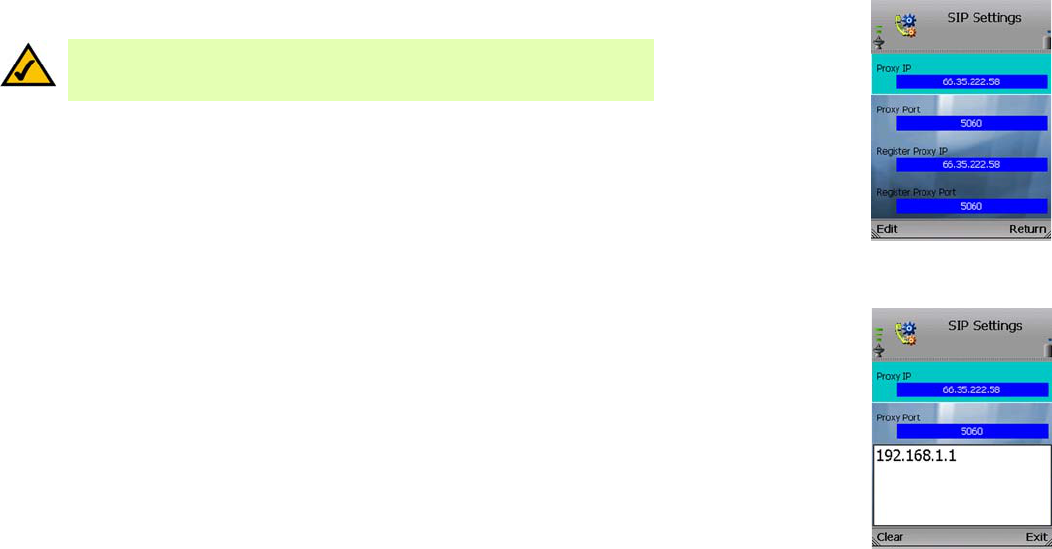
Wireless-G IP Phone
13
Chapter 3: Installing and Using the Wireless-G IP Phone
Setting up the Wireless-G IP Phone
8. A list of SIP settings will be displayed. For the Proxy IP setting, select Edit.
9. Enter the Proxy IP address in the new window, and then select Save.
Figure 3-12: Edit Proxy
IP
NOTE: The Proxy IP address and other information should have been supplied by
your Internet phone service provider. If you do not have this information, contact your
Internet phone service provider.
Figure 3-13: Save Proxy
IP

Wireless-G IP Phone
14 Chapter 3: Installing and Using the Wireless-G IP Phone
Setting up the Wireless-G IP Phone
10. Scroll down to Proxy Port, and select Edit.
11. Enter the Proxy Port number address in the new window, and then select Save.
12. Scroll down to Register Proxy IP, and select Edit.
13. Enter the Register Proxy IP address in the new window, and then select Save.
Figure 3-15: Save
Register Proxy IP
Figure 3-14: Save Proxy
Port

Wireless-G IP Phone
15
Chapter 3: Installing and Using the Wireless-G IP Phone
Setting up the Wireless-G IP Phone
14. Scroll down to Register Proxy Port, and select Edit.
15. Enter the Register Proxy Port number in the new window, and then select Save.
16. Scroll down to Outbound Proxy IP, and select Edit.
17. Enter the Outbound Proxy IP address in the new window, and then select Save.
Figure 3-16: Save
Register Proxy Port
Figure 3-17: Save
Outbound Proxy IP

Wireless-G IP Phone
16 Chapter 3: Installing and Using the Wireless-G IP Phone
Setting up the Wireless-G IP Phone
18. Scroll down to Outbound Proxy Port, and select Edit.
19. Enter the Outbound Proxy Port number in the new window, and then select Save.
20. If your Internet phone service provider did not provide an Expire Time setting, then keep the default setting,
3600 seconds, and proceed to step 20.
If your Internet phone service provider provided an Expire Time setting, then scroll down to Expire Time, and
select Edit.
21. Enter the Expire Time in the new window, and then select Save.
Figure 3-18: Edit
Outbound Proxy Port
Figure 3-19: Save Expire
Time

Wireless-G IP Phone
17
Chapter 3: Installing and Using the Wireless-G IP Phone
Setting up the Wireless-G IP Phone
22. Scroll down to Phone Number, and select Edit.
23. Enter the Phone Number you will use for Internet phone calls, and then select Save.
24. Scroll down to User Name, and select Edit.
25. Enter the User Name in the new window, and then select Save.
Figure 3-20: Save Phone
Number
Figure 3-21: Save User
Name

Wireless-G IP Phone
18 Chapter 3: Installing and Using the Wireless-G IP Phone
Setting up the Wireless-G IP Phone
26. Scroll down to Password, and select Edit.
27. Enter the Password, and then select Save.
28. On the SIP Settings screen, select Save.
Figure 3-22: Save
Password
Figure 3-23: Save SIP
Settings

Wireless-G IP Phone
19
Chapter 3: Installing and Using the Wireless-G IP Phone
Setting up the Wireless-G IP Phone
29. Select Return to return to the standby screen.
30. The standby screen will indicate that the IP Phone is ready to make or receive phone calls.
The installation of the Wireless-G IP Phone is complete. Proceed to the next section, “Using the
Wireless-G IP Phone.”
Figure 3-25: Standby
Screen
Figure 3-24: Return to
Standby Screen
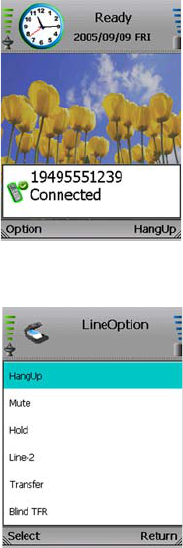
Wireless-G IP Phone
20 Chapter 3: Installing and Using the Wireless-G IP Phone
Using the Wireless-G IP Phone
Using the Wireless-G IP Phone
To make a call, enter the phone number you want to call. Then press the Call button. When you are on a phone
call, select Option to see a list of menu choices. Select HangUp to end the call.
To change the volume, use the + and - buttons on the side panel of the IP Phone. To switch to speakerphone,
press the speakerphone button, which is located above the volume buttons.
LineOption
When you are on a call, you have several options available. Press the left softkey to make a selection, and press
the right softkey to return to the previous menu. Use the navigation pad to scroll through menu choices.
HangUp. To end the call, select HangUp.
Mute. To mute the call, select Mute. Then select UnMute when you are ready to talk.
Hold. To put a call on hold, select Hold. Then select UnHold when you are ready to return to this call.
Line-2. When you want to switch back and forth between two separate conversations, use the Line-2 feature.
When you are on your first call, select Line-2 to switch to a second line. A new window will appear. Enter the
phone number of the second call, and then press the Call button. The current call will be put on hold, and you
will be switched to the second call. Select Switch to switch back to the first call.
Transfer. There are two types of transfer features available. Use the Transfer feature when you want to introduce
the caller you are transferring. Use the Blind TFR (Transfer) feature when you want to transfer the caller without
introduction. When you are on your call, select Transfer. A new window will appear. Enter the phone number to
which you want to transfer the call, and then press the Call button. When the second call is answered, speak to
the answering party and select Transfer. Then hang up.
Figure 3-26: Call
Connected
Figure 3-27: Line Options
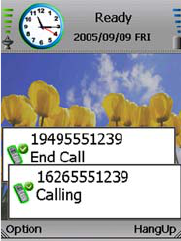
Wireless-G IP Phone
21
Chapter 3: Installing and Using the Wireless-G IP Phone
Using the Wireless-G IP Phone
Blind TFR. For a blind transfer, select Blind TFR. Dial the number to which you want to transfer the call. Select
Blind TFR again. Then hang up. When you are on your call, select Blind TFR. A new window will appear. Enter
the phone number to which you want to transfer the call, and then press the Call button. Then hang up.
Conference. When you are on your call, select Conference. A new window will appear. Enter the phone number
of the second call, and then press the Call button. When the second call is answered, select Conference.
Second Incoming Call
When you have a second call coming in, you can select Option to see a list of menu choices. Select HangUp to
end the call.
For more information about the buttons on the IP Phone, refer to “Chapter 2: Getting to Know the Wireless-G
IP Phone.”
For instructions on how to check your voicemail, contact your Internet phone service provider.
To configure additional settings, proceed to “Chapter 4: Configuring the Wireless-G IP Phone.”
Figure 3-28: Second Call
Wireless-G IP Phone
22 Chapter 3: Installing and Using the Wireless-G IP Phone
Using the Wireless-G IP Phone
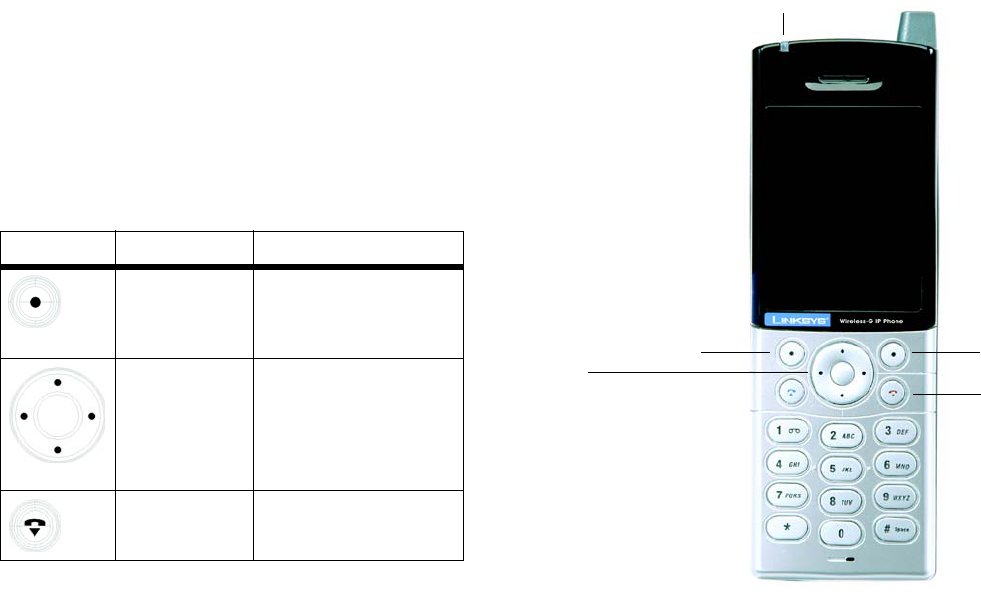
Wireless-G IP Phone
21
Chapter 4: Configuring the Wireless-G IP Phone
Instructions for Configuring the Wireless-G IP Phone
Chapter 4: Configuring the Wireless-G
IP Phone
Instructions for Configuring the Wireless-G IP Phone
Follow these instructions to configure the IP Phone’s settings. You will use these buttons to navigate
menus and select your choices.
Icon Button Name Function
Softkey Press the left or right softkey to
select the appropriate action
shown on the left- or right-
hand side of the screen.
Navigation Pad
and Center
Selection Key
To navigate menus and control
the cursor for the web browser,
use the navigation pad.
Use the center selection key to
make menu choices.
Power On/Off or
End Call
To exit a menu without making
changes, press this button.
Figure 4-1: Front Panel of IP
Phone
Power LED
Softkey
Power On/Off
or End Call
Softkey
Navigation Pad
and Center
Selection Key
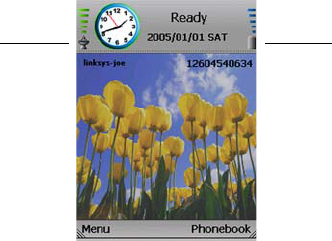
Wireless-G IP Phone
22 Chapter 4: Configuring the Wireless-G IP Phone
Status Information
Status Information
The standby screen will display a variety of information about the IP Phone.
Wireless Signal Strength
At the top of the screen, the icon on the left indicates wireless signal strength.
Time Display
The current time is shown. To change this time and its format, analog or digital, use the main menu.
Status of the IP Phone
This indicates whether the IP Phone is ready to make and receive calls.
Date Display
The date display gives you the current date. You can change this date using the main menu.
Battery Strength
The icon on the right of the screen indicates battery strength of the IP Phone.
Wireless Network Name
The screen displays the name of the wireless network used by the IP Phone.
Battery
Strength
Wireless
Signal
Strength
Figure 4-2: Standby
Screen
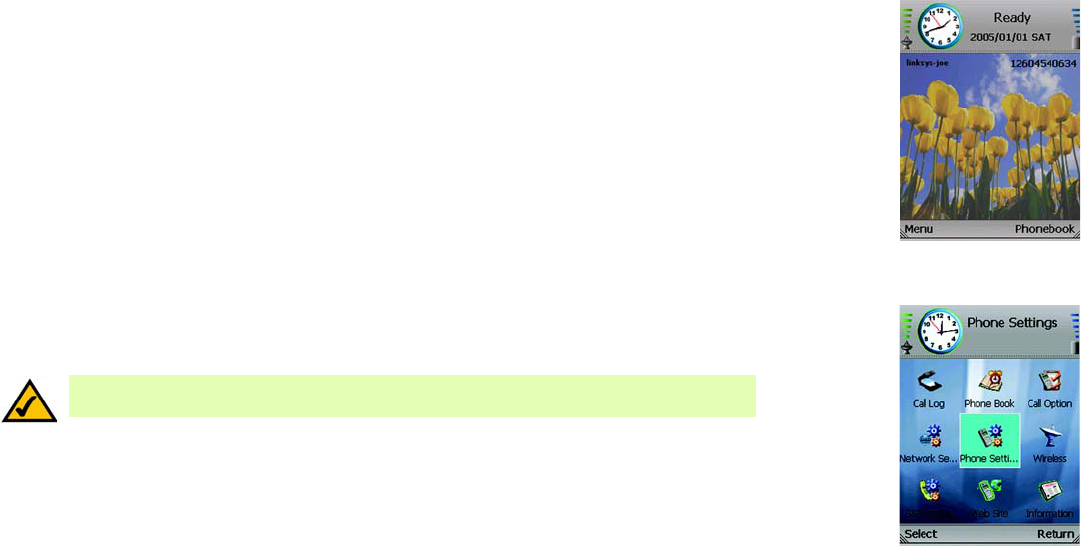
Wireless-G IP Phone
23
Chapter 4: Configuring the Wireless-G IP Phone
Settings of the Wireless-G IP Phone
Internet Phone Number
The Internet phone number of the IP Phone is shown.
Menu
Press the left softkey button to view the main menu. Its choices will be described in further details below.
Phonebook
Press the right softkey to access the Phonebook. This can also be accessed through the main menu.
Settings of the Wireless-G IP Phone
You will have nine menu choices: Call Log, Phone Book, Call Option, Network Settings, Phone Settings, Wireless,
SIP Settings, Web Site, and Information.
NOTE: Press the left softkey to make a selection, and press the right softkey to return to the
previous menu. Use the navigation pad to scroll through menu choices.
Figure 4-3: Standby
Screen
Figure 4-4: Main Menu
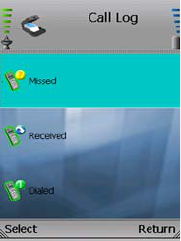
Wireless-G IP Phone
24 Chapter 4: Configuring the Wireless-G IP Phone
Settings of the Wireless-G IP Phone
Call Log
Scroll through these choices and press the left softkey to make a selection. Select Return to return to the
previous menu.
Missed. A list of missed calls will be displayed. Select Delete to delete a call. Select Return to return to the
previous menu.
Received. A list of received calls will be displayed. Select Delete to delete a call. Select Return to return to the
previous menu.
Dialed. A list of dialed calls will be displayed. Select Delete to delete a call. Select Return to return to the
previous menu. Figure 4-5: Call Log
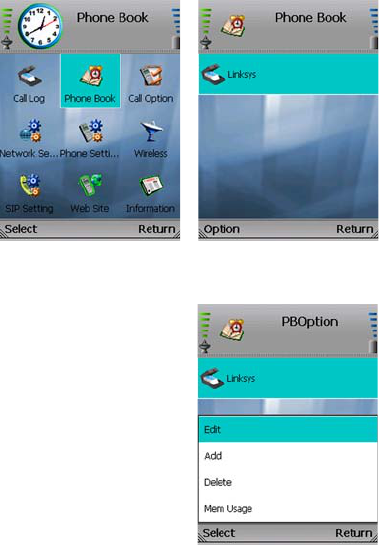
Wireless-G IP Phone
25
Chapter 4: Configuring the Wireless-G IP Phone
Settings of the Wireless-G IP Phone
Phone Book
You will see a list of contacts (when you have contacts in the Phone Book). Select Option to see
menu choices. Select Return to return to the previous menu.
Option
You have these choices: Edit (available when you have contacts in the Phone Book), Add, Delete (available when
you have contacts in the Phone Book), and Mem Usage. Select Return to return to the previous menu.
Edit. Select Edit to edit a contact’s information: Name, Home Number, Office Number, Mobile Number, SIP-Home
Number, SIP-Office Number, SIP-Mobile Number. For each setting, select Edit. Enter the appropriate information
in the new window. Select Save to save the new information, or select Clear to delete a character or number on-
screen. After you have finished your edits, select Save to return to the Phone Book screen.
Figure 4-6: Select
Phone Book
Figure 4-7: Phone Book
Figure 4-8: Phone Book
Options
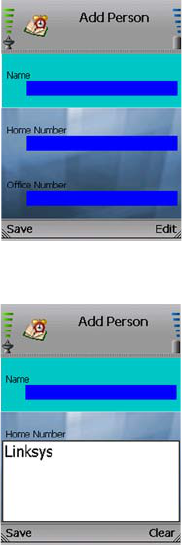
Wireless-G IP Phone
26 Chapter 4: Configuring the Wireless-G IP Phone
Settings of the Wireless-G IP Phone
Add. Select Add to add a new contact. Scroll through the different settings: Name, Home Number, Office
Number, Mobile Number, SIP-Home Number, SIP-Office Number, SIP-Mobile Number. For each setting, select
Edit. Enter the appropriate information in the new window. Select Save to save the new information, or select
Clear to delete a character or number on-screen. After you have entered all of the new contact information,
select Save to return to the Phone Book screen.
Delete. To delete a contact, scroll down the entries until the contact is highlighted. Select Option and then select
Delete. Then you will be automatically returned to the Phone Book screen.
Mem Usage. Select Mem Usage to find out how much memory has been used. The total number of phone book
entries available and number of entries used will be displayed. Select Exit to return to the Phone Book screen.
Figure 4-9: Add Person
Figure 4-10: Enter Name
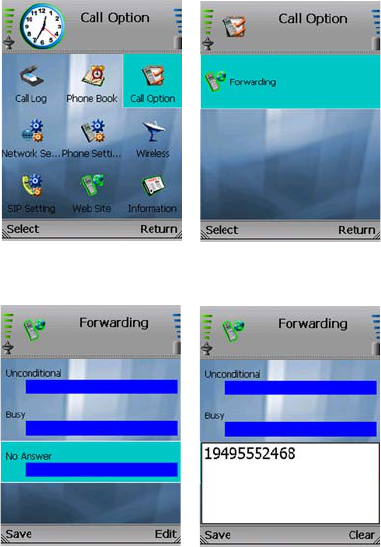
Wireless-G IP Phone
27
Chapter 4: Configuring the Wireless-G IP Phone
Settings of the Wireless-G IP Phone
Call Option
To forward calls, select Forwarding. Select Return to return to the previous menu.
Forwarding
Scroll through these choices and press the left softkey to make a selection. Select Save to return to
the Call Option screen.
Unconditional. If you want to forward all calls, select Edit. Enter the new number in the new
window. Select Save to save the new number, or select Clear to delete a number on-screen.
Busy. If you want calls forwarded when the IP Phone is busy, select Edit. Enter the new number in
the new window. Select Save to save the new number, or select Clear to delete a number on-
screen.
No Answer. If you want calls forwarded when you do not answer the IP Phone, select Edit. Enter the
new number in the new window. Select Save to save the new number, or select Clear to delete a
number on-screen.
Figure 4-11: Select Call
Option
Figure 4-12: Call Option
Figure 4-13: Forwarding Figure 4-14: Enter
Phone Number
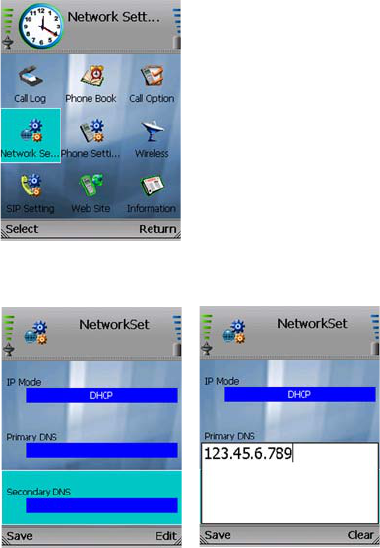
Wireless-G IP Phone
28 Chapter 4: Configuring the Wireless-G IP Phone
Settings of the Wireless-G IP Phone
Network Settings
You have two IP Modes available, DHCP and Fixed IP. In most cases, you should keep the default
setting, DHCP, if your network router or gateway will assign IP addresses to the IP Phone. If you want
to assign a static IP address to the IP Phone, select Fixed IP. To change the IP Mode, select Edit. The
on-screen choices will change depending on which IP Mode is selected. Select Save to return to the
previous menu.
DHCP
If DHCP is selected as the IP Mode, the screen will show these settings, Primary DNS and Secondary
DNS.
Primary DNS. To add or change the Primary DNS address, select Edit. Enter the new DNS IP
address in the new window. Select Save to save the new setting, or select Clear to delete a number
on-screen.
Secondary DNS. To add or change the Secondary DNS address, select Edit. Enter the new DNS IP
address in the new window. Select Save to save the new setting, or select Clear to delete a number
on-screen.
Figure 4-15: Select
Network Settings
Figure 4-16: Network
Settings - DHCP
Figure 4-17: Enter DNS
IP Address
ip address: the address
used to identify a
computer or device on a
network.
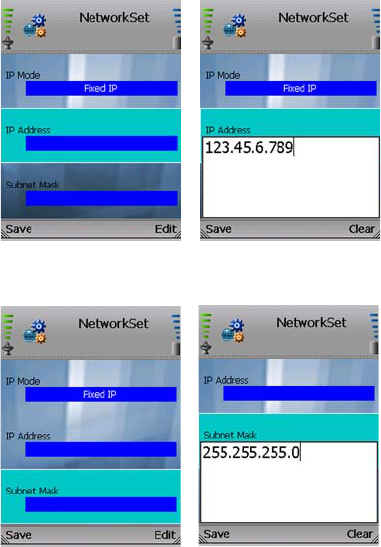
Wireless-G IP Phone
29
Chapter 4: Configuring the Wireless-G IP Phone
Settings of the Wireless-G IP Phone
Fixed IP
If Fixed IP is selected as the IP Mode, the screen will show these settings: IP Address, Subnet Mask,
Default Gateway, Primary DNS, and Secondary DNS.
IP Address. To add or change the IP Address, select Edit. Enter the new IP Address in the new
window. Select Save to save the new setting, or select Clear to delete a number on-screen.
Subnet Mask. To add or change the Subnet Mask, select Edit. Enter the new Subnet Mask in the
new window. Select Save to save the new setting, or select Clear to delete a number on-screen.
Default Gateway. To add or change the Default Gateway, select Edit. Enter the new IP address of
the Default Gateway in the new window. Select Save to save the new setting, or select Clear to
delete a number on-screen.
Primary DNS. To add or change the Primary DNS address, select Edit. Enter the new DNS IP
address in the new window. Select Save to save the new setting, or select Clear to delete a number
on-screen.
Secondary DNS. To add or change the Secondary DNS address, select Edit. Enter the new DNS IP
address in the new window. Select Save to save the new setting, or select Clear to delete a number
on-screen.
Figure 4-18: Network
Settings - Fixed IP
Figure 4-19: Enter IP
Address
Figure 4-20: Select
Subnet Mask
Figure 4-21: Enter
Subnet Mask
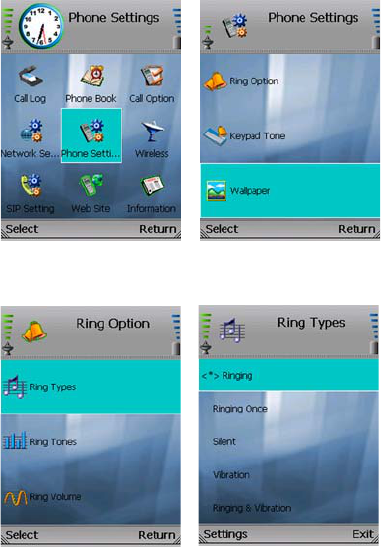
Wireless-G IP Phone
30 Chapter 4: Configuring the Wireless-G IP Phone
Settings of the Wireless-G IP Phone
Phone Settings
You can customize the settings of the IP Phone. You have these choices: Ring Option, Keypad Tone,
Wallpaper, Date & Time, Language, Power, and Upgrade. Select Return to return to the previous
menu.
Ring Option
Scroll through these choices and press the left softkey to make a selection. Select Return to return
to the Phone Settings screen.
Ring Types. There are five different ring types. The selected ring type is indicated by the <*>
symbol. Scroll through these choices to hear the actual ring style. Highlight the ring type you want to
select, and then select Settings to save your change. Select Exit to return to the Ring Option menu
without changing the ring type.
Ring Tones. There are seven ring tones. The selected ring tone is indicated by the <*> symbol.
Scroll through these choices to hear the actual ring tone. Highlight the ring tone you want to select,
and then select Settings to save your change. Select Exit to return to the Ring Option menu without
changing the ring tone.
Ring Volume. There are five ring volume levels. The selected ring volume level is indicated by the
<*> symbol. Scroll through these choices to hear the actual ring volume level. Highlight the ring
volume level you want to select, and then select Settings to save your change. Select Exit to return
to the Ring Option menu without changing the ring volume level.
Figure 4-22: Select
Phone Settings
Figure 4-23: Phone
Settings
Figure 4-24: Ring
Options
Figure 4-25: Ring Types

Wireless-G IP Phone
31
Chapter 4: Configuring the Wireless-G IP Phone
Settings of the Wireless-G IP Phone
Keypad Tone
To hear the actual keypad tone, scroll through these choices: Off, Soft, and Loud. The selected keypad tone is
indicated by the <*> symbol. Highlight the keypad tone you want to select, and then select Settings to save your
change. Select Exit to return to the Ring Option menu without changing the keypad tone.
Wallpaper
To see the different wallpaper choices, highlight the wallpaper you want to select, and then select Preview. Click
Exit to return to the Wallpaper menu. The selected wallpaper is indicated by the <*> symbol. Highlight the
wallpaper you want to select, and then press the center selection key (in the middle of the navigation pad) to
save your change. Select Exit to return to the Ring Option menu without changing the wallpaper.
Figure 4-26: Keypad
Tone
Figure 4-27: Wallpaper
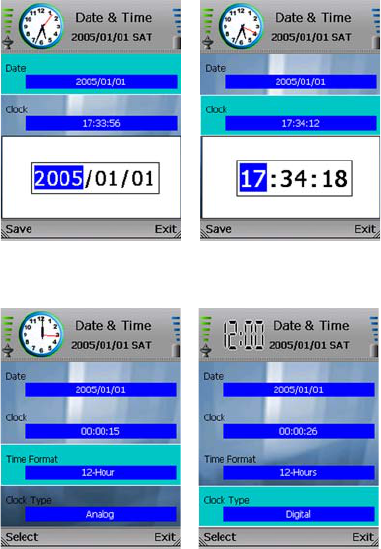
Wireless-G IP Phone
32 Chapter 4: Configuring the Wireless-G IP Phone
Settings of the Wireless-G IP Phone
Date & Time
You have six choices: Date, Clock, Time Format, Clock Type, Time Zone, and NTP Server. Select Exit
to return to the previous menu.
Date. Press the left softkey to select the Date setting. A new window will be displayed. Make your
changes, and then select Save. Select Exit to return to the Date & Time screen without changing the
date.
Clock. Press the left softkey to select the Clock setting. A new window will be displayed. Make your
changes, and then select Save. Select Exit to return to the Date & Time screen without changing the
time.
Time Format. There are two formats available, 12-Hours and 24-Hours. To change the format,
highlight Time Format, and press the left softkey.
Clock Type. There are two types available, Analog and Digital. To change the format, highlight Clock
Type, and press the left softkey.
Figure 4-28: Change
Date
Figure 4-29: Change
Clock
Figure 4-30: Change
Time Format
Figure 4-31: Change
Clock Type
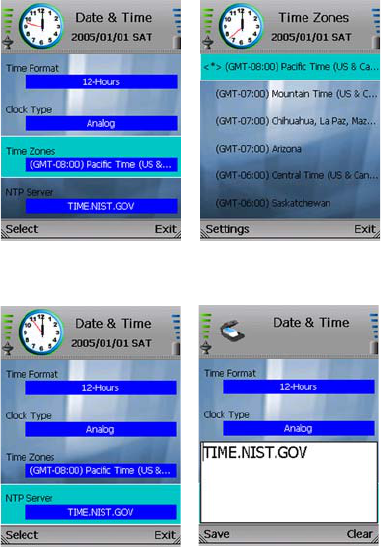
Wireless-G IP Phone
33
Chapter 4: Configuring the Wireless-G IP Phone
Settings of the Wireless-G IP Phone
Time Zone. Press the left softkey to select the Time Zone setting. A list of multiple time zones will be
displayed. The selected time zone is indicated by the <*> symbol. Scroll through these choices, and
highlight the time zone. Then select Settings to save your change. Select Exit to return to the Ring
Option menu without changing the time zone.
NTP Server. Press the left softkey to select the NTP Server setting. A new window will be displayed.
Enter the URL of the NTP Server. Select Save to save the new URL, or select Clear to delete a
character or number on-screen.
Figure 4-32: Select Time
Zone
Figure 4-33: Change
Time Zone
Figure 4-34: Select NTP
Server
Figure 4-35: Enter Name
of NTP Server
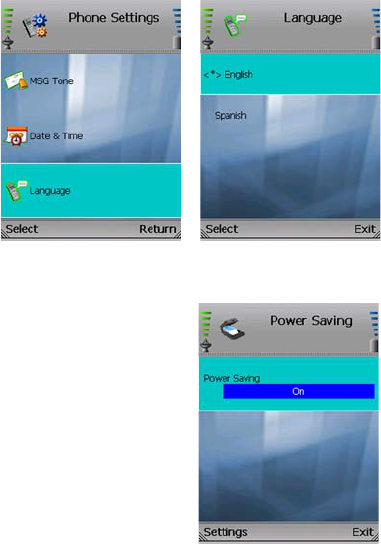
Wireless-G IP Phone
34 Chapter 4: Configuring the Wireless-G IP Phone
Settings of the Wireless-G IP Phone
Language
The selected language is indicated by the <*> symbol. Highlight the language you want to select,
and then press the left softkey to save your change. Select Exit to return to the Phone Settings menu
without changing the language.
Power
You have two Power Saving settings available, On and Off. In most cases, keep the default setting,
On, to enable the screensaver and reduce the IP Phone’s power consumption. If you want to keep
the IP Phone’s screen lit, select Settings. Select Exit to return to the Phone Settings menu without
changing the Power Saving setting.
Figure 4-37: Language
Figure 4-38: Change
Power Saving
Figure 4-36: Select
Language
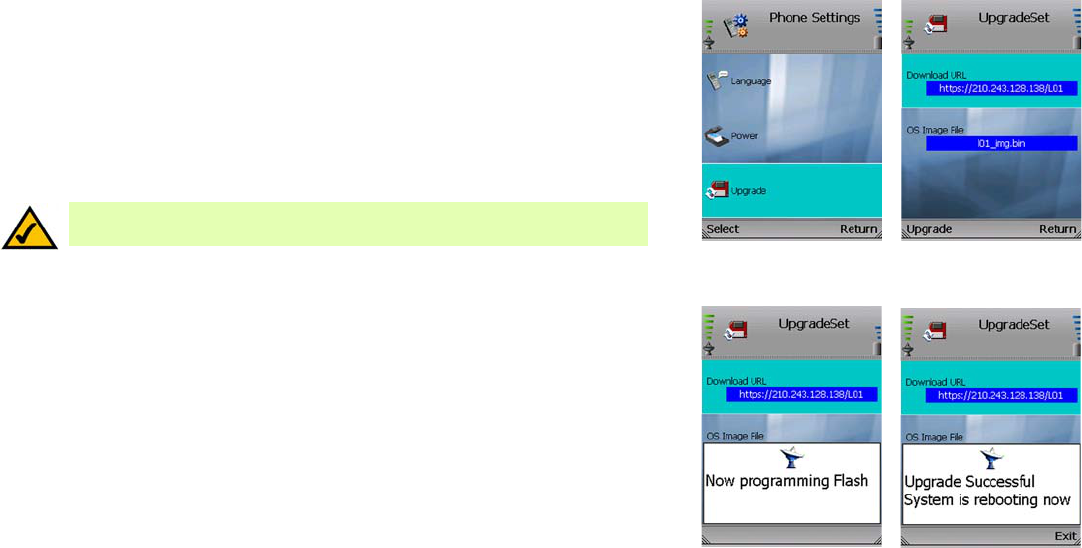
Wireless-G IP Phone
35
Chapter 4: Configuring the Wireless-G IP Phone
Settings of the Wireless-G IP Phone
Upgrade
The IP Phone is pre-configured with the correct Download URL and OS Image File entries.
Plug the USB mini-B connector of the included power adapter into the USB mini-B port of the IP
Phone. Then connect the power adapter to a standard electrical outlet.
Select Upgrade to start upgrading the IP Phone’s firmware, or select Return to cancel the upgrade
and return to the Phone Settings menu.
When the upgrade is complete, the IP Phone will automatically power itself off. Wait five seconds,
and then power on the IP Phone.
Figure 4-39: Select
Upgrade
Figure 4-40: Upgrade
NOTE: If the upgrade is interrupted, the IP Phone will revert to its old firmware, and
you can attempt the upgrade again.
Figure 4-41: Upgrade in
Progress
Figure 4-42: Upgrade
Successful
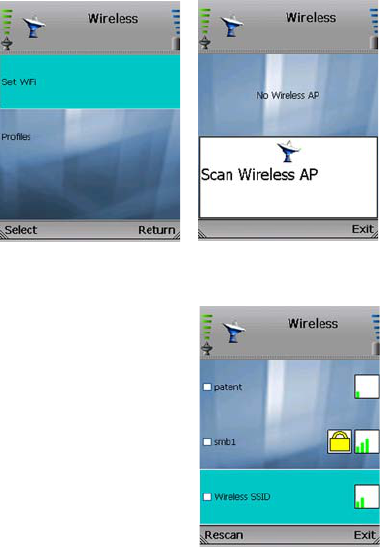
Wireless-G IP Phone
36 Chapter 4: Configuring the Wireless-G IP Phone
Settings of the Wireless-G IP Phone
Wireless
You have two choices, Set Wi-Fi and Profiles. If you want to scan for wireless networks in your local
area, select Set Wi-Fi. If you want to configure configuration profiles for different network setups,
select Profiles. Press the left softkey to make a selection. Select Return to return to the previous
menu.
Set Wi-Fi
After you have selected Set Wi-Fi, the IP Phone will scan the local area for wireless access points or
routers.
A list of wireless networks will be displayed and show their wireless network names, security
status (a lock indicates wireless security), and signal strength, which is indicated by a bar graph.
Scroll through the network choices, and press the center selection key (in the middle of the navigation pad) to
select the wireless network you want to use.
If the network you want is not shown, select Rescan for a new scan.
Figure 4-43: Wireless Figure 4-44: Scanning
for Wireless Networks
Figure 4-45: List of
Wireless Networks
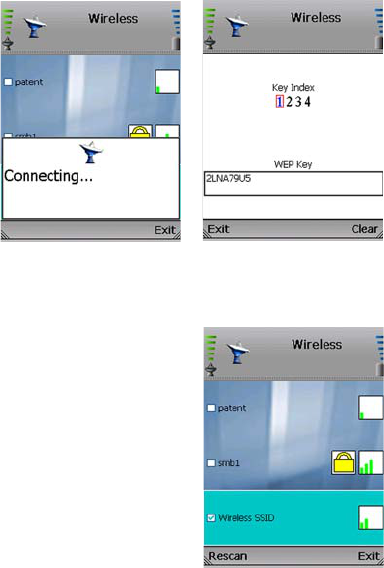
Wireless-G IP Phone
37
Chapter 4: Configuring the Wireless-G IP Phone
Settings of the Wireless-G IP Phone
The IP Phone will automatically connect to the network you have selected.
If security is enabled on the selected network, a new screen will appear. Using the navigation pad,
select the appropriate transmit key number and then move to the WEP Key field. Enter the network’s
WEP key. Select Exit to save your changes, or select Clear to delete a character or number.
You will be notified when the IP Phone has connected to the network, and a checkmark will appear
next to the name of the network.
Select Exit to return to the Wireless menu.
Figure 4-46: Connecting
to Wireless Network
Figure 4-47: Enter WEP
Key (for Secured
Network)
Figure 4-48: Connected
to Wireless Network
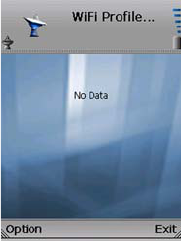
Wireless-G IP Phone
38 Chapter 4: Configuring the Wireless-G IP Phone
Settings of the Wireless-G IP Phone
Profiles
You will see a list of profiles (when you have profiles already configured). Select Option to see menu choices.
Select Exit to return to the previous menu.
Option
You have these choices: Edit (available when you have at least one existing profile), Add, Delete (available when
you have at least one existing profile), and Go Down/Up (available when you have more than one profile). The Edit
and Add options configure the same settings. The Edit option is used for changing existing profiles, while the Add
option is used for creating new profiles. Select Return to return to the previous menu.
Edit. Select Edit to edit a profile’s information: SSID (wireless network name), Wireless Mode, Authentication
Mode, Key Index, and WEP Key. Scroll through these choices, and select Edit to change a setting.
SSID. To enter the SSID, select Edit. Enter the new SSID in the new window. Select Save to save the new
SSID, or select Clear to delete a character or number on-screen.
Wireless Mode. You have a choice of Infrastructure and Ad hoc modes. To change the Wireless Mode, select
Edit.
Authentication Mode. You have a choice of Open System, Auto Switch, and Share Key. To change the
Authentication Mode, select Edit. A new window will open. Scroll through the modes, and select the
appropriate mode. Select Save to save the new Authentication Mode, or select Exit to return to the Edit
Profile menu without changing the Authentication Mode.
Key Index. For the index of transmit keys, you have a choice of 1-4. To specify which WEP key the IP Phone
will use, select Edit. A new window will open. Scroll through the numbers, and select the appropriate
Figure 4-49: Wi-Fi
Profiles
infrastructure: a wireless network
that is bridged to a wired network via
an access point.
ad-hoc: a group of wireless devices
communicating directly to each other
(peer-to-peer) without the use of an
access point.
ssid (service set identifier): your
wireless network’s name.
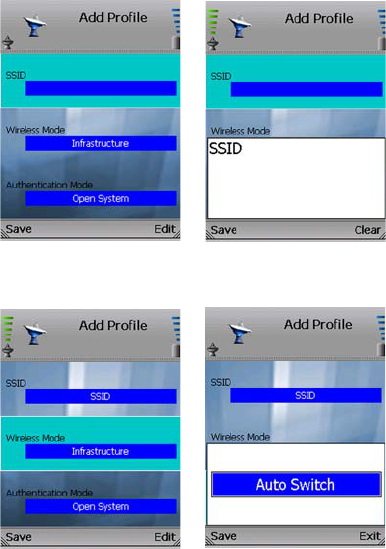
Wireless-G IP Phone
39
Chapter 4: Configuring the Wireless-G IP Phone
Settings of the Wireless-G IP Phone
transmit key number. Select Save to save the new transmit key number, or select Exit to return
to the Edit Profile menu without changing the number.
WEP Key. To enter the WEP Key, select Edit. Enter the new WEP Key in the new window. Select
Save to save the new WEP Key, or select Clear to delete a character or number on-screen.
Select Save to save the new settings and return to the Wi-Fi Profiles screen.
Add. Select Add to create a profile and enter its information: SSID (wireless network name),
Wireless Mode, Authentication Mode, Key Index, and WEP Key. Scroll through these choices, and
select Edit to change a setting.
SSID. To enter the SSID, select Edit. Enter the new SSID in the new window. Select Save to
save the new SSID, or select Clear to delete a character or number on-screen.
Wireless Mode. You have a choice of Infrastructure and Ad hoc modes. To change the Wireless
Mode, select Edit.
Authentication Mode. You have a choice of Open System, Auto Switch, and Share Key. To
change the Authentication Mode, select Edit. A new window will open. Scroll through the
modes, and select the appropriate mode. Select Save to save the new Authentication Mode, or
select Exit to return to the Add Profile menu without changing the Authentication Mode.
Figure 4-53: Change
Authentication Mode
Figure 4-51: Enter SSID
Figure 4-52: Change
Wireless Mode
Figure 4-50: Select SSID
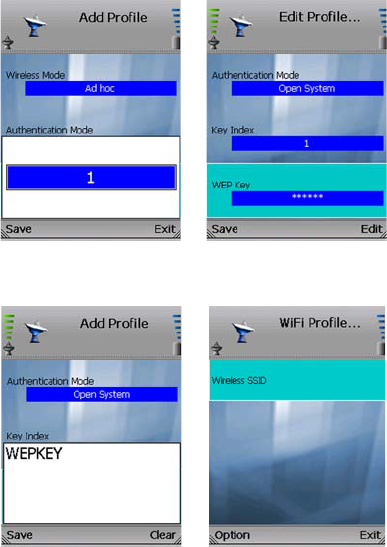
Wireless-G IP Phone
40 Chapter 4: Configuring the Wireless-G IP Phone
Settings of the Wireless-G IP Phone
Key Index. For the index of transmit keys, you have a choice of 1-4. To specify which WEP key
the IP Phone will use, select Edit. A new window will open. Scroll through the numbers, and
select the appropriate transmit key number. Select Save to save the new transmit key number,
or select Exit to return to the Add Profile menu without changing the number.
WEP Key. To enter the WEP Key, select Edit. Enter the new WEP Key in the new window. Select
Save to save the new WEP Key, or select Clear to delete a character or number on-screen.
Select Save to save the new settings and return to the Wi-Fi Profiles screen.
Delete. To delete a profile, scroll down the entries until the profile is highlighted. Select Option and
then select Delete. Then you will be automatically returned to the Wi-Fi Profiles screen.
Go Down/Up. You can rearrange the order of the profiles on your list. To move a profile, scroll
through the entries until the profile is highlighted. Select Option and then select Go Down or Go
Up to move the entry. Then you will be automatically returned to the Wi-Fi Profiles screen.
Figure 4-56: Enter WEP
Key
Figure 4-57: Profile
Added
Figure 4-55: Edit WEP
Key
Figure 4-54: Change
Transmit Key
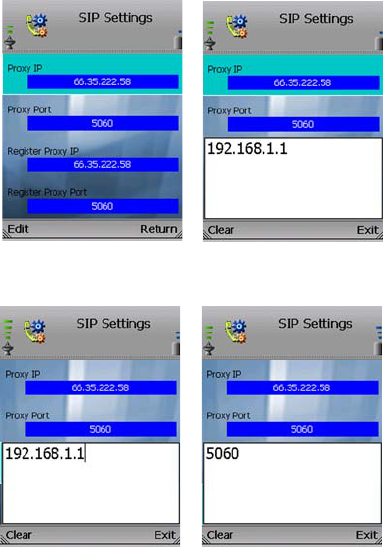
Wireless-G IP Phone
41
Chapter 4: Configuring the Wireless-G IP Phone
Settings of the Wireless-G IP Phone
SIP Settings
SIP settings are used to configure your Internet phone service. The necessary setup information is
supplied by your Internet phone service provider. If you do not have this information, contact your
Internet phone service provider before you make any changes. Select Save to return to the previous
menu.
Proxy IP. To add or change the Proxy IP address, select Edit. Enter the new Proxy IP address in the
new window. Select Save to save the new setting, or select Clear to delete a number on-screen.
Proxy Port. To add or change the Proxy Port number, select Edit. Enter the new Proxy Port number
in the new window. Select Save to save the new setting, or select Clear to delete a number on-
screen.
Register Proxy IP. To add or change the Register Proxy IP address, select Edit. Enter the new
Register Proxy IP address in the new window. Select Save to save the new setting, or select Clear
to delete a number on-screen.
Register Proxy Port. To add or change the Register Proxy Port number, select Edit. Enter the new
Register Proxy Port number in the new window. Select Save to save the new setting, or select Clear
to delete a number on-screen.
Figure 4-58: Edit Proxy IP Figure 4-59: Save Proxy IP
Figure 4-60: Save
Register Proxy IP
Figure 4-61: Save
Register Proxy Port
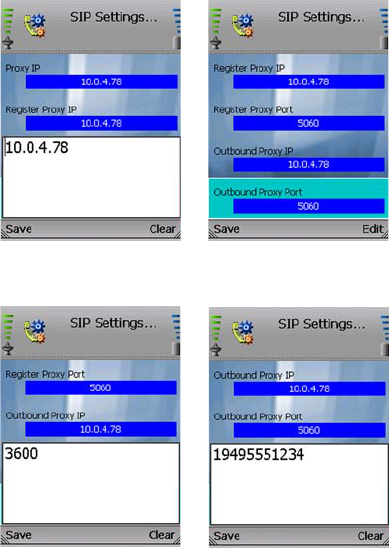
Wireless-G IP Phone
42 Chapter 4: Configuring the Wireless-G IP Phone
Settings of the Wireless-G IP Phone
Outbound Proxy IP. To add or change the Outbound Proxy IP address, select Edit. Enter the new
Outbound Proxy IP address in the new window. Select Save to save the new setting, or select Clear
to delete a number on-screen.
Outbound Proxy Port. To add or change the Outbound Proxy Port number, select Edit. Enter the
new Outbound Proxy Port number in the new window. Select Save to save the new setting, or
select Clear to delete a number on-screen.
Expire Time. If your Internet phone service provider did not provide an Expire Time setting, then
keep the default setting, 3600 seconds. If your Internet phone service provider provided an Expire
Time setting, then scroll down to Expire Time, and select Edit. Enter the Expire Time in the new
window. Select Save to save the new setting, or select Clear to delete a number on-screen.
Phone Number. To add or change the Phone Number you will use for Internet phone calls, select
Edit. Enter the new Phone Number in the new window. Select Save to save the new setting, or
select Clear to delete a number on-screen.
Figure 4-62: Save
Outbound Proxy IP
Figure 4-63: Edit
Outbound Proxy Port
Figure 4-64: Save Expire
Time
Figure 4-65: Save Phone
Number
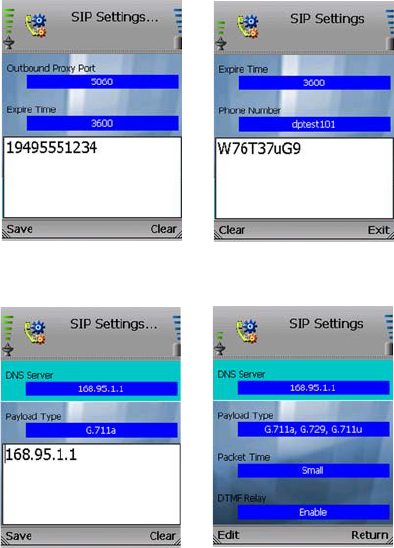
Wireless-G IP Phone
43
Chapter 4: Configuring the Wireless-G IP Phone
Settings of the Wireless-G IP Phone
User Name. To add or change the User Name, select Edit. Enter the new User Name in the new
window. Select Save to save the new setting, or select Clear to delete a character or number on-
screen.
Password. To add or change the Password, select Edit. Enter the new Password in the new
window. Select Save to save the new setting, or select Clear to delete a character or number on-
screen.
DNS Server. To add or change the IP address of the DNS Server, select Edit. Enter the new DNS
Server IP address in the new window. Select Save to save the new setting, or select Clear to
delete a number on-screen.
Payload Type. G.711a, G.729, and G.7111u are the three Payload Types available. They are listed in
order of preference. To change the order of preference, select Edit until the appropriate order of
preference is displayed on-screen.
Packet Time. You have two Packet Time lengths available, Small and Large. To change the time
period, select Edit until the appropriate Packet Time is displayed on-screen.
DTMF Relay. You can enable or disable the DTMF Relay feature. To enable or disable the feature,
select Edit.
UDP Port. To add or change the UDP Port number, select Edit. Enter the new UDP Port number in
the new window. Select Save to save the new setting, or select Clear to delete a number on-
screen.
RTP Port. To add or change the RTP Port number, select Edit. Enter the new RTP Port number in
the new window. Select Save to save the new setting, or select Clear to delete a number on-
screen.
Figure 4-66: Save User
Name
Figure 4-67: Save
Password
Figure 4-68: Save DNS
Server
Figure 4-69: Change
Payload Type
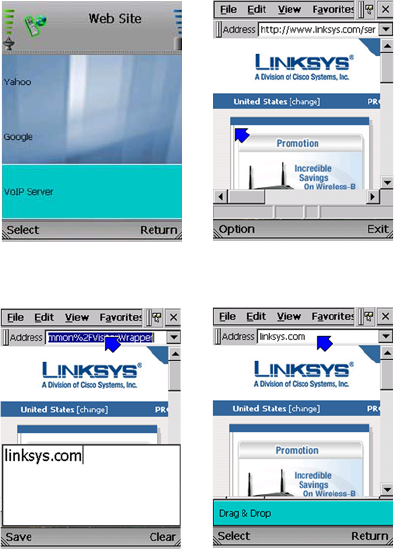
Wireless-G IP Phone
44 Chapter 4: Configuring the Wireless-G IP Phone
Settings of the Wireless-G IP Phone
Web Site
A list of web sites will be shown. Scroll through these choices and press the left softkey to make a
selection. Select Return to return to the previous menu.
When the web site is displayed, use the navigation pad to control cursor. Press the center selection
key to select menu choices and highlight items. Select Exit to return to the previous menu.
To visit a different website, select the current web address in the Address field. Begin entering the
new web address, and a new window will automatically appear. When you have finished entering
the new web address, select Save.
To change how the cursor works, select Option. If your cursor uses the Click feature, the Drag &
Drop feature will be available. If your cursor uses the Drag & Drop feature, the Click feature will be
available. Press the left softkey to select the new cursor feature, or select Return to return to the
website.
Figure 4-70: Web Site Figure 4-71: Visit Web
Site
Figure 4-72: Enter New
Web Address
Figure 4-73: Select Drag
& Drop
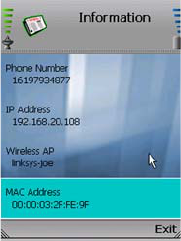
Wireless-G IP Phone
45
Chapter 4: Configuring the Wireless-G IP Phone
Settings of the Wireless-G IP Phone
Information
The status information of the IP Phone and its software is displayed on this read-only screen. Scroll through the
settings to view them. Select Exit to return to the previous menu.
Phone Number. Displayed here is the Phone Number of the IP Phone.
IP Address. Displayed here is the IP Address of the IP Phone.
Wireless AP. Displayed here is the name of the wireless network used by the IP Phone. (This is also known as
the SSID.)
MAC Address. Displayed here is the MAC Address of the IP Phone.
eBoot Version. Displayed here is the version number of the eBoot software.
Image Version. Displayed here is the version number of the image software.
SIP Version. Displayed here is the version number of the SIP software.
UI Version. Displayed here is the version number of the UI (User Interface) software.
Figure 4-74: Information
Wireless-G IP Phone
46 Chapter 4: Configuring the Wireless-G IP Phone
Settings of the Wireless-G IP Phone
Wireless-G IP Phone
45
Appendix A: Troubleshooting
Common Problems and Solutions
Appendix A: Troubleshooting
This appendix provides solutions to problems that may occur during the installation and operation of the
Wireless-G IP Phone. Read the description below to solve your problems. If you can't find an answer here, check
the website of your Internet phone service provider or the Linksys website at www.linksys.com/international.
Common Problems and Solutions
1. I don’t hear a dial tone.
Go through this checklist until your problem is solved:
• Check your router and network connection to the Internet.
• Follow these instructions to reboot your cable or DSL modem, IP Phone, and router:
1. Power off your modem by unplugging its power adapter.
2. Power off the router by unplugging its power adapter.
3. Power off the IP Phone by pressing and holding down the Power On/Off button for two seconds.
4. Wait two minutes. Power on your modem by plugging its power adapter into an electrical outlet.
5. Wait two minutes. Power on the router by plugging its power adapter into an electrical outlet.
6. Wait five minutes. Power on the IP Phone by pressing and holding down the Power On/Off button for
two seconds.
7. Reboot one of your networked computers, and check for an active Internet connection.
8. Pick up the IP Phone. You should now have a dial tone.
• Set up port forwarding on your router. You must specify that four port ranges be forwarded to the IP
address of the IP Phone. These four port ranges are as follows: 5060-5061 (UDP), 53-53 (UDP),
69-69 (UDP), and 10000-20000 (UDP).

Wireless-G IP Phone
46 Appendix A: Troubleshooting
Common Problems and Solutions
If you have a non-Linksys router, refer to its documentation for instructions. If you have a Linksys router,
then follow these instructions:
1. On one of your networked computers, open your web browser.
2. Access the Router’s Web-based Utility by going to http://192.168.1.1 or the IP address of the
Router.
3. A login screen will appear. Leave the User Name field blank. Enter the Router’s password (the
default is admin) in the Password field. Then click the OK button.
4. Click the Applications & Gaming tab, and then click the Port Range Forwarding tab.
5. For each port range you must specify, enter a different name in the Application field. Then enter the
number or range of external port(s) used by the IP Phone.
6. Select the protocol you will be using, UDP.
7. Enter the IP address of the IP Phone. For example, if the IP Phone’s IP address is 192.168.1.100, you
would enter 100 in the field provided.
8. Repeat steps 5-7 until you have entered all four port ranges for the IP Phone.
9. Check the Enable option for the port services you want to use.
10. When you have completed the configuration, click the Save Settings button.
Application Start and End Protocol IP Address Enable
Internet phone 1 5060 to 5061 UDP (IP address of IP Phone) X
Internet phone 2 53 to 53 UDP (IP address of IP Phone) X
Internet phone 3 69 to 69 UDP (IP address of IP Phone) X
Internet phone 4 10000 to 20000 UDP (IP address of IP Phone) X
Wireless-G IP Phone
47
Appendix A: Troubleshooting
Common Problems and Solutions
2. When I make a telephone call, the call doesn’t go through; instead, I hear a fast busy signal.
Go through this checklist until your problem is solved:
• Follow these instructions to reboot your cable or DSL modem, IP Phone, and router:
1. Power off your cable or DSL modem by unplugging its power adapter.
2. Power off the router by unplugging its power adapter.
3. Power off the IP Phone by pressing and holding down the Power On/Off button for two seconds.
4. Wait two minutes, and then power on your cable or DSL modem by plugging its power adapter into
an electrical outlet.
5. Wait two minutes, and then power on the router by plugging its power adapter into an electrical
outlet.
6. Wait five minutes. Power on the IP Phone by pressing and holding down the Power On/Off button for
two seconds.
7. Reboot one of your networked computers, and check for an active Internet connection.
8. Pick up the handset or telephone. You should now have a dial tone.
• Set up port forwarding on your router. You must specify that four port ranges be forwarded to the IP
address of the IP Phone. These four port ranges are as follows: 5060-5061 (UDP), 53-53 (UDP),
69-69 (UDP), and 10000-20000 (UDP).
If you have a non-Linksys router, refer to its documentation for instructions.
If you have a Linksys router, then follow these instructions:
1. On one of your networked computers, open your web browser.
2. Access the Router’s Web-based Utility by going to http://192.168.1.1 or the IP address of the
Router.
3. A login screen will appear. Leave the User Name field blank. Enter the Router’s password (the
default is admin) in the Password field. Then click the OK button.
4. Click the Applications & Gaming tab, and then click the Port Range Forwarding tab.
5. For each port range you must specify, enter a different name in the Application field. Then enter the
number or range of external port(s) used by the IP Phone.

Wireless-G IP Phone
48 Appendix A: Troubleshooting
Common Problems and Solutions
6. Select the protocol you will be using, UDP.
7. Enter the IP address of the IP Phone. For example, if the IP Phone’s IP address is 192.168.1.100, you
would enter 100 in the field provided.
8. Repeat steps 5-7 until you have entered all four port ranges for the IP Phone.
9. Check the Enable option for the port services you want to use.
10. When you have completed the configuration, click the Save Settings button.
3. When I’m on a telephone call, words are dropped intermittently.
Go through this checklist until your problem is solved:
• Are you using a wireless router and cordless phone? If so, the router and cordless phone may be using
the same frequency and interfere with each other. Move the cordless phone farther away from the
router.
• There may be heavy network activity, particularly if you are running a server or using a file sharing
program. Try to limit network or Internet activity during any Internet telephone call. For example, if you
are running a file sharing program, files may be uploading in the background even though you are not
downloading any files, so make sure you exit the program before you make an Internet phone call.
Application Start and End Protocol IP Address Enable
Internet phone 1 5060 to 5061 UDP (IP address of IP Phone) X
Internet phone 2 53 to 53 UDP (IP address of IP Phone) X
Internet phone 3 69 to 69 UDP (IP address of IP Phone) X
Internet phone 4 10000 to 20000 UDP (IP address of IP Phone) X
Wireless-G IP Phone
49
Appendix A: Troubleshooting
Common Problems and Solutions
• There may not be enough bandwidth available for your Internet phone call. You may want to test your
bandwidth using one of the bandwidth tests available online. If necessary, access your service account
at your Internet phone service provider’s website, and reduce the bandwidth requirements for your
service. For more information, refer to your Internet phone service provider’s website.
4. The IP Phone does not ring, and my calls automatically go to voicemail.
Go through this checklist until your problem is solved:
• Check the ringer volume on the IP Phone, and make sure it is set to an audible level.
• Follow these instructions to reboot your cable or DSL modem, IP Phone, and router:
1. Power off your cable or DSL modem by unplugging its power adapter.
2. Power off the router by unplugging its power adapter.
3. Power off the IP Phone by pressing and holding down the Power On/Off button for two seconds.
4. Wait two minutes, and then power on your cable or DSL modem by plugging its power adapter into
an electrical outlet.
5. Wait two minutes, and then power on the router by plugging its power adapter into an electrical
outlet.
6. Wait five minutes. Power on the IP Phone by pressing and holding down the Power On/Off button for
two seconds.
7. Reboot one of your networked computers, and check for an active Internet connection.
• Set up port forwarding on your router. You must specify that four port ranges be forwarded to the IP
address of the IP Phone. These four port ranges are as follows: 5060-5061 (UDP), 53-53 (UDP),
69-69 (UDP), and 10000-20000 (UDP).
Note: By default, the IP Phone uses a dynamic IP address assigned by your router. For port forwarding,
you may need to assign a static IP address to the IP Phone. Contact your Internet phone service provider
for assistance.

Wireless-G IP Phone
50 Appendix A: Troubleshooting
Common Problems and Solutions
If you have a non-Linksys router, refer to its documentation for instructions. If you have a Linksys router,
then follow these instructions:
1. On one of your networked computers, open your web browser.
2. Access the Router’s Web-based Utility by going to http://192.168.1.1 or the IP address of the
Router.
3. A login screen will appear. Leave the User Name field blank. Enter the Router’s password (the
default is admin) in the Password field. Then click the OK button.
4. Click the Applications & Gaming tab, and then click the Port Range Forwarding tab.
5. For each port range you must specify, enter a different name in the Application field. Then enter the
number or range of external port(s) used by the IP Phone.
6. Select the protocol you will be using, UDP.
7. Enter the IP address of the IP Phone. For example, if the IP Phone’s IP address is 192.168.1.100, you
would enter 100 in the field provided.
8. Repeat steps 5-7 until you have entered all four port ranges for the IP Phone.
9. Check the Enable option for the port services you want to use.
10. When you have completed the configuration, click the Save Settings button.
Application Start and End Protocol IP Address Enable
Internet phone 1 5060 to 5061 UDP (IP address of IP Phone) X
Internet phone 2 53 to 53 UDP (IP address of IP Phone) X
Internet phone 3 69 to 69 UDP (IP address of IP Phone) X
Internet phone 4 10000 to 20000 UDP (IP address of IP Phone) X
Wireless-G IP Phone
51
Appendix A: Troubleshooting
Frequently Asked Questions
5. The power LED does not light up.
Go through this checklist until your problem is solved:
• Unplug the power adapter from the IP Phone. Wait five seconds. Re-connect the power adapter.
• You may be using the wrong power adapter. Make sure the power adapter you are using is the one
included with the IP Phone.
Frequently Asked Questions
Can I make calls if my Internet connection is down?
No. Your high-speed Internet connection must be active when you make Internet phone calls.
Can I make calls while I’m browsing the Internet?
Yes. You can make Internet phone or fax calls while browsing the Internet. However, your web browsing may
affect the quality of your telephone call, depending on the amount of upstream data traffic passing through your
Internet connection.
Can I receive calls while my network is down?
You cannot directly receive calls while your network is down. However, your Internet phone service account may
allow you to forward calls to a different telephone number, such as a cellular phone number. For more
information, visit the website of your Internet phone service provider.
Wireless-G IP Phone
52 Appendix A: Troubleshooting
Frequently Asked Questions
Wireless-G IP Phone
53
Appendix B: Glossary
Appendix B: Glossary
This glossary contains some basic networking terms you may come across when using this product. For more advanced
terms, see the complete Linksys glossary at http://www.linksys.com/glossary.
Access Point - A device that allows wireless-equipped computers and other devices to communicate with a wired network.
Also used to expand the range of a wireless network.
Ad-hoc - A group of wireless devices communicating directly with each other (peer-to-peer) without the use of an access
point.
Bandwidth - The transmission capacity of a given device or network.
Bit - A binary digit.
Boot - To start a device and cause it to start executing instructions.
Broadband - An always-on, fast Internet connection.
Browser - An application program that provides a way to look at and interact with all the information on the World Wide Web.
Byte - A unit of data that is usually eight bits long
Cable Modem - A device that connects a computer to the cable television network, which in turn connects to the Internet.
Default Gateway - A device that forwards Internet traffic from your local area network.
DHCP (Dynamic Host Configuration Protocol) - A networking protocol that allows administrators to assign temporary IP
addresses to network computers by “leasing” an IP address to a user for a limited amount of time, instead of assigning
permanent IP addresses.
Wireless-G IP Phone
54 Appendix B: Glossary
DMZ (Demilitarized Zone) - Removes the Router's firewall protection from one PC, allowing it to be “seen” from the Internet.
DNS (Domain Name Server) - The IP address of your ISP's server, which translates the names of websites into IP addresses.
Domain - A specific name for a network of computers.
Download - To receive a file transmitted over a network.
DSL (Digital Subscriber Line) - An always-on broadband connection over traditional phone lines.
Dynamic IP Address - A temporary IP address assigned by a DHCP server.
Encryption - Encoding data transmitted in a network.
Ethernet - IEEE standard network protocol that specifies how data is placed on and retrieved from a common transmission
medium.
Firmware - The programming code that runs a networking device.
FTP (File Transfer Protocol) - A protocol used to transfer files over a TCP/IP network.
Full Duplex - The ability of a networking device to receive and transmit data simultaneously.
Gateway - A device that interconnects networks with different, incompatible communications protocols.
Half Duplex - Data transmission that can occur in two directions over a single line, but only one direction at a time.
HTTP (HyperText Transport Protocol) - The communications protocol used to connect to servers on the World Wide Web.
Infrastructure - A wireless network that is bridged to a wired network via an access point.
IP (Internet Protocol) - A protocol used to send data over a network.
IP Address - The address used to identify a computer or device on a network.
Wireless-G IP Phone
55
Appendix B: Glossary
ISP (Internet Service Provider) - A company that provides access to the Internet.
LAN - The computers and networking products that make up your local network.
MAC (Media Access Control) Address - The unique address that a manufacturer assigns to each networking device.
Mbps (MegaBits Per Second) - One million bits per second; a unit of measurement for data transmission.
Network - A series of computers or devices connected for the purpose of data sharing, storage, and/or transmission between
users.
Packet - A unit of data sent over a network.
Passphrase - Used much like a password, a passphrase simplifies the WEP encryption process by automatically generating
the WEP encryption keys for Linksys products.
Port - The connection point on a computer or networking device used for plugging in cables or adapters.
RJ-45 (Registered Jack-45) - An Ethernet connector that holds up to eight wires.
Roaming - The ability to take a wireless device from one access point's range to another without losing the connection.
Router - A networking device that connects multiple networks together.
Server - Any computer whose function in a network is to provide user access to files, printing, communications, and other
services.
SSID (Service Set IDentifier) - Your wireless network's name.
Static IP Address - A fixed address assigned to a computer or device that is connected to a network.
Static Routing - Forwarding data in a network via a fixed path.
Subnet Mask - An address code that determines the size of the network.
Wireless-G IP Phone
56 Appendix B: Glossary
Switch - 1. A data switch that connects computing devices to host computers, allowing a large number of devices to share a
limited number of ports. 2. A device for making, breaking, or changing the connections in an electrical circuit.
TCP (Transmission Control Protocol) - A network protocol for transmitting data that requires acknowledgement from the
recipient of data sent.
TCP/IP (Transmission Control Protocol/Internet Protocol) - A set of instructions PCs use to communicate over a network.
Telnet - A user command and TCP/IP protocol used for accessing remote PCs.
TFTP (Trivial File Transfer Protocol) - A version of the TCP/IP FTP protocol that has no directory or password capability.
Throughput - The amount of data moved successfully from one node to another in a given time period.
Topology - The physical layout of a network.
TX Rate - Transmission Rate.
Upgrade - To replace existing software or firmware with a newer version.
Upload - To transmit a file over a network.
URL (Uniform Resource Locator) - The address of a file located on the Internet.
WAN (Wide Area Network)- The Internet.
WEP (Wired Equivalent Privacy) - A method of encrypting network data transmitted on a wireless network for greater security.
WLAN (Wireless Local Area Network) - A group of computers and associated devices that communicate with each other
wirelessly.
Wireless-G IP Phone
57
Appendix C: Specifications
Appendix C: Specifications
Model WIP330
Standards 802.11b, 802.11g
Channels 11 Channels (US, Canada), 13 Channels (Europe)
Transmit Power 12 dBm for 802.11b and 802.11g @ Normal Temp Range
External Interface One Mini USB 1.1 Port, One Stereo Ear Phone Jack
Display 2.2 inch (55.9 mm) (240 x 320 pixels)
Network Protocols TCP/IP
Security WEP (64/128), WPA-PSK Encryption
QoS ToS
Voice Protocols SIP v2 Session Initiation Protocol (RFC3261), SDP (RFC2327)
Voice Codecs G.711 u/A-law, G.729a/b
Wireless-G IP Phone
58 Appendix C: Specifications
DTMF Transmission In-band, Out-band (RFC2833)
Voice Quality Acoustic Echo Cancellation
Jitter Buffer Control
Comfortable Noise Generation
Packet Loss Concealment
Dimensions 1.84" x 5.32" x 0.74"
(W x H x D) (46.7 mm x 135.2 mm x 18.8 mm)
Unit Weight 4.20 oz. (0.12 kg)
Power 3.7V, 1250mAh Lithium Battery, 5V, 1A AC Adapter
Certifications FCC, cUL, CE
Operating Temp. 32ºF to 113ºF (0ºC to 45ºC)
Storage Temp. -4ºF to 131ºF (-20ºC to 55ºC)
Operating Humidity 10% to 85% Relative Humidity, Non-Condensing
Storage Humidity 10% to 95% Non-Condensing
Wireless-G IP Phone
59
Appendix D: Warranty Information
Appendix D: Warranty Information
LIMITED WARRANTY
Your Internet phone service provider warrants to You that, for a period of one year (the “Warranty Period”), your Linksys Product will be substantially free of
defects in materials and workmanship under normal use. Your exclusive remedy and Your Internet phone service provider’s entire liability under this
warranty will be for Your Internet phone service provider at its option to repair or replace the Product or refund Your purchase price less any rebates. This
limited warranty extends only to the original purchaser.
If the Product proves defective during the Warranty Period call Your Internet phone service provider Technical Support in order to obtain a Return
Authorization Number, if applicable. If You are requested to return the Product, mark the Return Authorization Number clearly on the outside of the package.
You are responsible for shipping defective Products to Your Internet phone service provider.
ALL IMPLIED WARRANTIES AND CONDITIONS OF MERCHANTABILITY OR FITNESS FOR A PARTICULAR PURPOSE ARE LIMITED TO THE DURATION OF THE
WARRANTY PERIOD. ALL OTHER EXPRESS OR IMPLIED CONDITIONS, REPRESENTATIONS AND WARRANTIES, INCLUDING ANY IMPLIED WARRANTY OF NON-
INFRINGEMENT, ARE DISCLAIMED. Some jurisdictions do not allow limitations on how long an implied warranty lasts, so the above limitation may not apply to
You. This warranty gives You specific legal rights, and You may also have other rights which vary by jurisdiction.
This warranty does not apply if the Product (a) has been altered, except by Your Internet phone service provider, (b) has not been installed, operated, repaired,
or maintained in accordance with instructions supplied by Your Internet phone service provider, or (c) has been subjected to abnormal physical or electrical
stress, misuse, negligence, or accident. In addition, due to the continual development of new techniques for intruding upon and attacking networks, Your
Internet phone service provider does not warrant that the Product will be free of vulnerability to intrusion or attack.
TO THE EXTENT NOT PROHIBITED BY LAW, IN NO EVENT WILL YOUR INTERNET PHONE SERVICE PROVIDER BE LIABLE FOR ANY LOST DATA, REVENUE OR
PROFIT, OR FOR SPECIAL, INDIRECT, CONSEQUENTIAL, INCIDENTAL OR PUNITIVE DAMAGES, REGARDLESS OF THE THEORY OF LIABILITY (INCLUDING
NEGLIGENCE), ARISING OUT OF OR RELATED TO THE USE OF OR INABILITY TO USE THE PRODUCT (INCLUDING ANY SOFTWARE), EVEN IF Your Internet phone
service provider HAS BEEN ADVISED OF THE POSSIBILITY OF SUCH DAMAGES. IN NO EVENT WILL Your Internet phone service provider’ LIABILITY EXCEED THE
AMOUNT PAID BY YOU FOR THE PRODUCT. The foregoing limitations will apply even if any warranty or remedy provided under this Agreement fails of its
essential purpose. Some jurisdictions do not allow the exclusion or limitation of incidental or consequential damages, so the above limitation or exclusion
may not apply to You.
Please contact your Internet phone service provider regarding the warranty for the Product.
Wireless-G IP Phone
60 Appendix D: Warranty Information
Wireless-G IP Phone
61
Appendix E: Regulatory Information
Appendix E: Regulatory Information
FCC Statement
This product has been tested and complies with the specifications for a Class B digital device, pursuant to Part 15 of the FCC Rules. These limits are designed
to provide reasonable protection against harmful interference in a residential installation. This equipment generates, uses, and can radiate radio frequency
energy and, if not installed and used according to the instructions, may cause harmful interference to radio communications. However, there is no guarantee
that interference will not occur in a particular installation. If this equipment does cause harmful interference to radio or television reception, which is found
by turning the equipment off and on, the user is encouraged to try to correct the interference by one or more of the following measures:
• Reorient or relocate the receiving antenna.
• Increase the separation between the equipment and receiver.
• Connect the equipment into an outlet on a circuit different from that to which the receiver is connected.
• Consult the dealer or an experienced radio/TV technician for help.
This device complies with Part 15 of the FCC Rules. Operation is subject to the following two conditions: (1) This device may not cause harmful interference,
and (2) this device must accept any interference received, including interference that may cause undesired operation.
FCC Caution: Any changes or modifications not expressly approved by the party responsible for compliance could void the user's authority to operate this
equipment.
IMPORTANT NOTE:
FCC Radiation Exposure Statement:
This equipment complies with FCC radiation exposure limits set forth for an uncontrolled environment. End users must follow the specific operating
instructions for satisfying RF exposure compliance.
This transmitter must not be co-located or operating in conjunction with any other antenna or transmitter.
This equipment has been SAR-evaluated. The Maximum average SAR(1g) test value is 0.303 W/kg.
Linksys declares that WIP 330 ( FCC ID: Q87-WIP330) is limited in CH1~CH11 for 2.4 GHz by specified firmware controlled in U.S.A.
Wireless-G IP Phone
62 Appendix E: Regulatory Information
Safety Notices
Caution: To reduce the risk of fire, use only No. 26 AWG or larger telecommunication line cord.
Do not use this product near water, for example, in a wet basement or near a swimming pool.
Avoid using this product during an electrical storm. There may be a remote risk of electric shock from lightning.
Industry Canada
This device complies with Industry Canada ICES-003 and RSS210 rules.
IC Statement
Operation is subject to the following two conditions:
1. This device may not cause interference and
2. This device must accept any interference, including interference that may cause undesired operation of the device.
Règlement d’Industry Canada
Les conditions de fonctionnement sont sujettes à deux conditions:
1. Ce périphérique ne doit pas causer d’interférence et
2. Ce périphérique doit accepter toute interférence, y compris les interférences pouvant perturber le bon fonctionnement de ce périphérique

Wireless-G IP Phone
63
Appendix E: Regulatory Information
User Information for Consumer Products Covered by EU Directive 2002/96/EC on Waste Electric and Electronic Equipment (WEEE)
This document contains important information for users with regards to the proper disposal and recycling of Linksys
products. Consumers are required to comply with this notice for all electronic products bearing the following symbol:

Wireless-G IP Phone
64 Appendix E: Regulatory Information

Wireless-G IP Phone
65
Appendix E: Regulatory Information
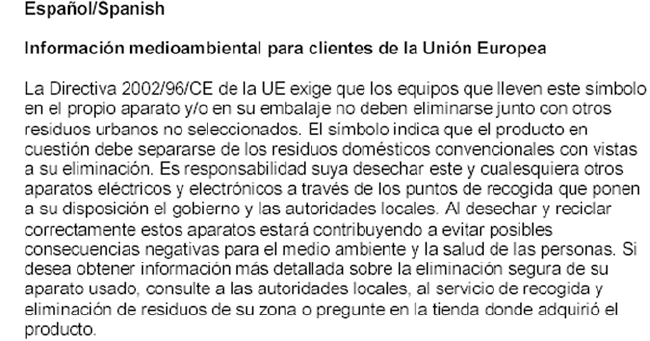
Wireless-G IP Phone
66 Appendix E: Regulatory Information

Wireless-G IP Phone
67
Appendix E: Regulatory Information

Wireless-G IP Phone
68 Appendix E: Regulatory Information

Wireless-G IP Phone
69
Appendix E: Regulatory Information

Wireless-G IP Phone
70 Appendix E: Regulatory Information

Wireless-G IP Phone
71
Appendix E: Regulatory Information

Wireless-G IP Phone
72 Appendix E: Regulatory Information

Wireless-G IP Phone
73
Appendix E: Regulatory Information

Wireless-G IP Phone
74 Appendix E: Regulatory Information
For more information, visit www.linksys.com.
Wireless-G IP Phone
75
Appendix F: Contact Information
Appendix F: Contact Information
Need to contact Linksys?
Visit us online for information on the latest products and updates
to your existing products at: http://www.linksys.com or
ftp.linksys.com
Can't find information about a product you want to buy
on the web? Do you want to know more about networking
with Linksys products? Give our advice line a call at: 800-546-5797 (LINKSYS)
Or fax your request in to: 949-823-3002
If you experience problems with any Linksys product,
you can call us at: 800-326-7114
Don't wish to call? You can e-mail us at: support@linksys.com
Wireless-G IP Phone
76 Appendix F: Contact Information
www.linksys.com